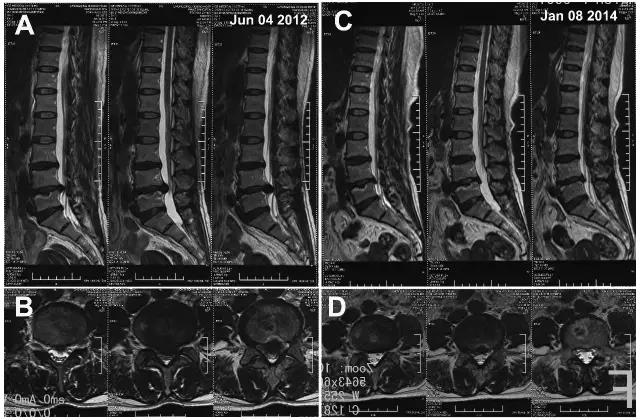腰椎间盘突出自发性重吸收(Spontaneous resorption/regression of lumbar disc herniation)是指腰椎间盘突出症患者未经手术治疗或侵入性治疗而发生的突出髓核自发性消失或明显缩小。随着CT和MRI的普及应用,腰椎间盘突出自发性重吸收的病例报道日益增多。也有学者对重吸收的特点和机制进行了研究,期待为非手术治疗腰椎间盘突出症提供理论依据。
1.病例报道
女,56岁。因腰部疼痛向双下肢放射2月而于2012年6月门诊。查体:双侧直腿抬高试验阳性,双下肢感觉、运动、反射正常,马鞍区感觉正常。MRI示腰4/5椎间盘中央巨大突出,椎管占位约3/4(图1 A,B)。诊断为腰4/5椎间盘突出症,建议患者入院行经皮椎间孔镜腰椎间盘髓核摘除术(PELD)手术治疗。患者拒绝手术,自行在家行热敷、牵引、按摩治疗,腰腿痛逐渐减轻,仅遗留有右侧臀痛。2014年1月门诊复查MRI显示腰4/5突出椎间盘自发性吸收,突出髓核90%以上消失(图1C,D)。

图1:腰椎间盘突出自发性重吸收。A, B: 腰椎MRI矢状位和横断面显示腰4/5椎间盘巨大突出。C, D: 腰椎MRI矢状位和横断面显示19个月后腰4/5椎间盘突出自发性重吸收。
2.讨论
2.1 腰椎间盘突出自发性重吸收的病例报道和特点
椎间盘突出,包括颈椎、胸椎和腰椎椎间盘突出,都有自发性重吸收的病例报道,其中,腰椎间盘突出自发性重吸收的病例报道最多。按时间顺序,Guinto(1例, CT, 1984)[1]、Teplick (11例, CT, 1985)[2]、Singh(1例, MRI, 1999)[3]、Slavin(1例, MRI, 2001)[4]、Sakai(1例, MRI, 2007)[5]、Birbilis (1例, MRI, 2007)[6]、Borota(1例, MRI, 2008)[7]、Gezici(1例, MRI, 2009)[8]、Orief(5例腰椎1例颈椎, MRI, 2012)[9]、Kim(3例, MRI, 2013)[10]等报道了不同例数的腰椎病例。在颈椎,Lester(1例, MRI, 1989)[11]、Song(1例, MRI, 1999)[12]、Vinas(4例, MRI, 2001)[13]等报道了个案病例。胸椎的报道最少,仅有Haro(2例, MRI, 2008)[14]报道。国内刘锦涛(2例, MRI, 2010)[15]报道了腰椎病例。
以上这些病例报道,在腰椎发生部位,腰2/3、腰3/4、腰4/5和腰5/骶1椎间盘都有报道。重吸收的时间最长的2年,最短的2月。腰椎间盘重吸收的类型报道包括游离型、经韧带型、硬脊膜下游离型、复发游离型。由于腰椎间盘突出重吸收发生率很低,没有统计学上的报道,仅有两位作者做了临床研究。Autio[16]观察到大部分腰椎病人在1年内被重吸收,在41到50岁的人群中最容易发生重吸收,随着重吸收发生临床症状逐渐减轻。Ahn[17]发现游离型最容易发生重吸收,认为髓核游离进入硬膜外腔接触血运而造成的。髓核越大,游离越远,与血供接触面积越大,发生重吸收的可能也越大。
2.2腰椎间盘突出自发性重吸收的机制
腰椎椎间盘突出重吸收的机制不完全清楚,一般认为与炎症反应和自身免疫反应两方面作用有关。炎症反应是因为髓核游离暴露在血供环境,单核巨噬细胞等炎性细胞浸润而引起的。炎症反应表现两种作用,一是炎细胞直接吞噬吸收髓核;二是炎细胞产生多种炎性介质,激活髓核组织中自溶性的金属基质蛋白酶(matrix metalloproteinases, MMPs)而引起自发吸收。重组MMP-7, MMP-3在体内和体外都能减少髓核组织的重量和促进髓核的吸收[18]。正常髓核中MMPs的含量很少,而在突出的髓核中MMPs mRNA (-3、-8、-9、-13和-14)不但表达增高[19],而且也影响巨噬细胞向突出髓核的渗透[20]。目前报道突出髓核检测到的炎症因子有:单核细胞趋化蛋白1(monocyte chemoattractant protein-1) 和白细胞介素8(interleukin-8, IL-8),前者趋化单核细胞[21];前列腺素E2(prostaglandinE2, PGE2)及前列腺素F2α(prostaglandinF2α, PGF2α),后者可增加MMP-1 和MMP-3 mRNA的表达[22];肿瘤坏死因子α(tumor necrosis factor alpha, TNFα),TNFα是炎症的指标,但其促进髓核吸收并没有得到体内实验的证据[23];血管内皮细胞生长因子(vascular endothelial growth factor, VEGF),VEGF在突出髓核组织和巨噬细胞都高表达,通过TNFα诱导,通过非血管生成的方式重吸收髓核[24]。
髓核的自身免疫反应是因为突出髓核组织发现了高表达的IL-4、IL-6、IL-12、IL-17和干扰素γ(interferon-gamma, IFNγ),这些与免疫有关的炎症因子被认为是椎间盘病变后接触血运后浸润的巨噬细胞释放的[25]。IL-6可以促进单核细胞转化为巨噬细胞,同时激活了T淋巴细胞及B淋巴细胞。IL-12激活T淋巴细胞,也通过释放IFNγ增强NK细胞的活性。IL-17可以激活T细胞亚群-Th17细胞的自身免疫反应。
参考文献:
1.Guinto FC Jr, Hashim H, Stumer M. CT demonstration of disk regressionafter conservative therapy.AJNR Am J Neuroradiol. 1984; 5(5):632-3
2.TeplickJG, Haskin ME. Spontaneous regression of herniated nucleus pulposus. AJR Am J Roentgenol 1985; 145:371–5.
3.Singh P, Singh AP. Spontaneous resorption of extruded lumber disc fragment. Neurol India. 1999; 47(4):338-9.
4.Slavin KV, Raja A, Thornton J, Wagner FC Jr. Spontaneous regression of a largelumbar disc herniation: report of an illustrative case. Surg Neurol.2001;56(5):333-6; discussion 337.
5.Sakai T, Tsuji T, Asazuma T, Yato Y, Matsubara O,Nemoto K. Spontaneous resorption in recurrent intradural lumbar disc herniation.Case report. J Neurosurg Spine. 2007; 6(6):574-8.
6.Birbilis TA, Matis GK, Theodoropoulou EN. Spontaneous regression of a lumbardisc herniation: case report. Med Sci Monit. 2007; 13(10):CS121-3.
7.Borota L, Jonasson P, Agolli A. Spontaneous resorption of intradurallumbar disc fragments. Spine J. 2008; 8(2):397-403.
8.Gezici AR, Ergün R. Spontaneous regression of a huge subligamentous extruded disc herniation:short report of an illustrative case. Acta Neurochir (Wien).2009; 151(10):1299-300.
9.Orief T, Orz Y, Attia W, Almusrea K. Spontaneous resorption ofsequestrated intervertebral disc herniation. World Neurosurg. 2012;77(1):146-52.
10.Kim ES, Oladunjoye AO,Li JA, Kim KD. Spontaneous regression of herniated lumbar discs. J Clin Neurosci. 2013;24. pii: S0967-5868(13)00552-3. doi: 10.1016/j.jocn.2013.10.008. [Epub ahead ofprint]
11.Lester JW Jr, Miller WA,Carter MP, Hemphill JM. MR of childhood calcified herniated cervical disk with spontaneousresorption. AJNR Am J Neuroradiol. 1989;10(5 Suppl):S48-50.
12.Song JH, Park HK, ShinKM. Spontaneous regression of a herniated cervical disc in a patient withmyelopathy. Case report. J Neurosurg. 1999; 90(1 Suppl):138-40.
13. Vinas FC, Wilner H,Rengachary S. The spontaneous resorption of herniated cervical discs. J Clin Neurosci. 2001;8(6):542-6.
14.Haro H, Domoto T,Maekawa S, Horiuchi T, Komori H, Hamada Y. Resorption of thoracic disc herniation. Report of 2 cases. J Neurosurg Spine. 2008;8(3):300-4.
15.刘锦涛, 姜宏, 徐坤林, 张志刚, 李红卫, 马奇翰. 破裂游离型腰椎间盘突出组织重吸收2例报告. 颈腰痛杂志. 2010; 31(2): 160
16.Autio RA, Karppinen J,Niinimäki J, Ojala R, Kurunlahti M, Haapea M, Vanharanta H, Tervonen O.Determinants of spontaneousresorption of intervertebral disc herniations. Spine (Phila Pa 1976).2006; 31(11):1247-52.
17.Ahn SH, Ahn MW, Byun WM. Effect of thetransligamentous extension of lumbar disc herniations on their regression andthe clinical outcome of sciatica. Spine (Phila Pa 1976). 2000; 25(4):475-80.
18.18 Haro H, Komori H,Kato T, Hara Y, Tagawa M, Shinomiya K, Spengler DM. Experimental studies on the effects of recombinant human matrixmetalloproteinases on herniated disc tissues--how to facilitate the naturalresorption process of herniated discs. J Orthop Res. 2005; 23(2):412-9.
19.Tsarouhas A, Soufla G, Katonis P, Pasku D, Vakis A, Spandidos DA. Transcript levels ofmajor MMPs and ADAMTS-4 in relation to the clinicopathological profile ofpatients with lumbar disc herniation. Eur Spine J.2011; 20(5):781-90.
20.Doita M, Kanatani T,Ozaki T, Matsui N, Kurosaka M, Yoshiya S. Influence of macrophage infiltration of herniated disc tissue on theproduction of matrix metalloproteinases leading to disc resorption. Spine (Phila Pa 1976).2001; 26(14):1522-7.
21.Burke JG, Watson RW,McCormack D, Dowling FE, Walsh MG, Fitzpatrick JM. Spontaneous production of monocyte chemoattractant protein-1 andinterleukin-8 by the human lumbar intervertebral disc. Spine (Phila Pa 1976).2002;27(13):1402-7.
22.Vo NV, Sowa GA, Kang JD, Seidel C, Studer RK. Prostaglandin E2 andprostaglandin F2α differentially modulate matrix metabolism of human nucleuspulposus cells. J Orthop Res. 2010; 28(10):1259-66.
23.Autio RA, Karppinen J,Niinimäki J, Ojala R, Veeger N, Korhonen T, Hurri H, Tervonen O. The effect of infliximab, amonoclonal antibody against TNF-alpha, on disc herniation resorption: arandomized controlled study. Spine (Phila Pa 1976).2006; 31(23):2641-5.
24.Haro H, Kato T, Komori H, Osada M, Shinomiya K. Vascular endothelialgrowth factor (VEGF)-induced angiogenesis in herniated disc resorption. J Orthop Res. 2002; 20(3):409-15.
25.Shamji MF, Setton LA, Jarvis W, So S, Chen J, Jing L, Bullock R, Isaacs RE, Brown C, Richardson WJ. Proinflammatorycytokine expression profile in degenerated and herniated human intervertebral disctissues.Arthritis Rheum. 2010; 62(7):1974-82.
本文来源:脊柱外科医生张正丰













